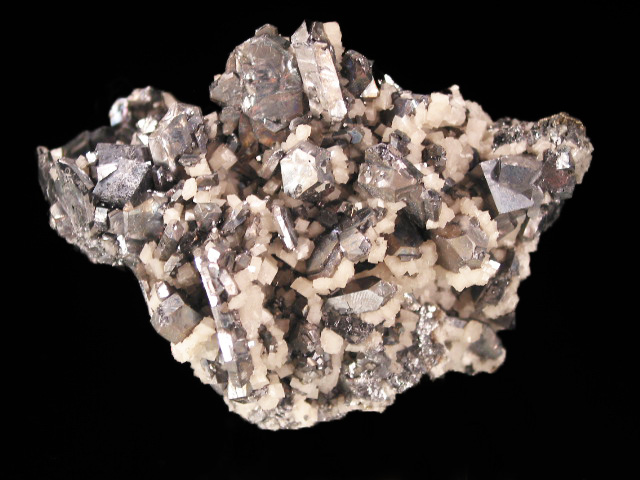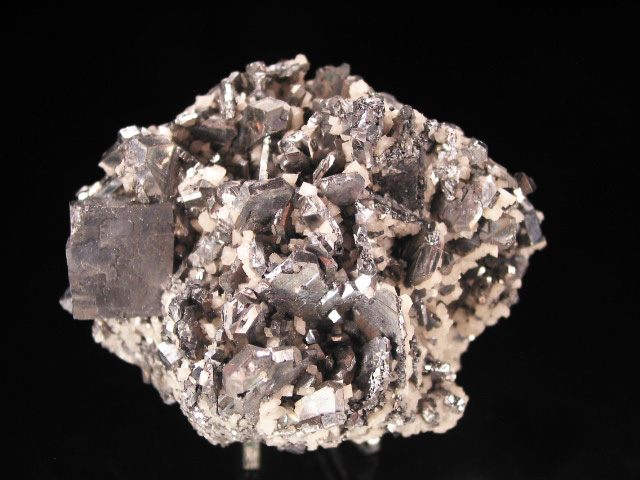Midwest, Burma, and Mixed
I was accumulating pieces for separate themed updates, then just decided to put them all together. This page contains a mix of pieces from the American Midwest, including some old Tri-State material and quarry calcites, as well as a selection of minerals from Mogok. Of particular note in the latter category are a couple painite crystals and a serendibite. There are a few other random things thrown in as well.
BMM01 Calcite
Pugh Quarry, Custar, Ohio, United States
40.9x 29.0x 21.5 cm
$0
A very large cabinet specimen of calcite, from the Pugh Quarry in Ohio. I normally stay away from pieces that are so large, but I liked the overall composition, and more importantly, was amazed by the relative lack of damage. A piece this size usually suffers from crystals broken under the weight of the specimen--and although a couple downward facing terminations are incomplete, all the main crystals-- including the important ones at the top and center-- are damage free
This is both a very good specimen of Midwestern calcite, as well as a potential decorator piece.
If at all possible I would prefer to hand this off at a show. It can be shipped, but please bear in mind that this thing is heavy.
BMM02 Fluorite
Elmwood mine, Carthage, Smith Co., Tennessee, United States
15.5x 14.3x 9.5 cm
$0
A large and showy fluorite cube from the Elmwood Mine. Contacted on the back and etched on the sides (the white on the side is etching), not 100% perfect but with little enough damage to look like a much more impressive and expensive specimen than it is, particularly when displayed diagonally as shown in the first picture.
Measures 10.4 cm on edge.
BMM03 Galena with Sphalerite
Picher Field, Tri-state District, Oklahoma, United States (pre-1967)
18.5x 10.5x 10.0 cm
$0
A large cabinet specimen, hosting a number of sharp galena cubes on a chert marix, covered with tousands of small "ruby jack" sphalerite crystals that impart a welcome contrast.
These are not to be confused with the contemporary Viburnum Trend, Missouri specimens. Although part of Missouri was included in the Tristate district, those workings were on the western side of the state. The more recent production comes from the eastern side. Personally, I like these old examples better-- although the lusters are usually duller, they tend to have a sharper, more geometric appearance than the Viburnum specimens, with their messy compound faces. The chert matrix is also somewhat cleaner in appearance than the breccia (?) that is found with the Viburnum examples.
Operated since the 1850's, the last mine in the district closed in 1967. Like other towns in the district, the nearby town of Picher was deserted, a victim of the toxic mine tailing dunes that earned it a place on the list of Superfund sites.
BMM05 Calcite
Irving Materials Quarry, Anderson, Madison Co., Indiana, United States
4.2x 2.7x 2.0 cm
$185
A twinned orange calcite on matrix, from Indiana. Along with the calcites from the Berry Materials quarry (also in Indiana) these are my favorite Midwestern calcites-- though these are somewhat harder to find.
BMM06 Calcite
Irving Materials Quarry, Anderson, Madison Co., Indiana, United States
2.2x 1.6x 1.2 cm
$65
A twinned orange calcite on matrix, from Indiana, this one a thumbnail. Along with the calcites from the Berry Materials quarry (also in Indiana) these are my favorite Midwestern calcites-- though these are somewhat harder to find.
BMM07 Fluorite
Minerva No. 1 Mine, Cave-in-Rock, Hardin Co., Illinois, United States
4.1x 2.4x 1.8 cm
$0
A cluster of fairly transparent (though a bit cloudy) purplish blue fluorite from Illinois. Etched on the back.
The last mine in the area closed in 1995.
BMM08 Calcite on Celestite
Monroe Co., Michigan, United States
8.7x 5.3x 2.0 cm
$0
A beautiful example of calcite on celestite, with small calcite crystals entirely covering one side of the celestite, though leaving it exposed on the other. The colors on this piece are a little more saturated than what is typical for the area, particularly on the larger calcite crystal-- if it were not for the celestite, that calcite would almost looks like something from the Deccan traps.
Most of the celestite on the market comes from Madagascar. These Michigan samples are not exactly rare, but I liked the calcite combination on this one-- usually they are just plain blue blades.
BMM09 Wulfenite with Mimetite
San Francisco Mine, Cucurpe, Sonora, Mexico
7.3x 4.1x 2.3 cm
$0
A brightly colored specimen of wulfenite with mimetite, from one of the most famous wulfenite producing localities in the world. This is an older piece, dating to sometime in the 70's or early 80's.
BMM10 Wulfenite with Mimetite
San Francisco Mine, Cucurpe, Sonora, Mexico
4.5x 4.4x 3.6 cm
$165
A brightly colored specimen of wulfenite with mimetite, from one of the most famous wulfenite producing localities in the world. This is an older piece, dating to sometime in the 70's or early 80's.
BMM11 Wulfenite with Mimetite
San Francisco Mine, Cucurpe, Sonora, Mexico
7.6x 5.1x 2.8 cm
$185
A brightly colored specimen of wulfenite with mimetite, from one of the most famous wulfenite producing localities in the world. This is an older piece, dating to sometime in the 70's or early 80's.
This piece is best displayed resting backwards at an angle, as the main crystal can be better seen. There is a bit of damage.
BMM13 Rose Quartz
Laranjeiras, Galiléia, Doce Valley, Minas Gerais, Brazil
3.5x 2.7x 2.0 cm
$135
Although rose quartz is frequently seen as a lapidary material, actual crystals of this quartz variety are only known from a few locations, primarily in Brazil and Maine. This is a nicely colored little miniature. One crystal is missing, but you have to look very closely to see this-- in fact, I totally missed it while photographing and only saw while taking its measurements. Regardless, it displays exactly as shown.
BMM14 Painite
Wetloo, Kyauk-Pyat-That, Mogok Township, Myanmar (Burma)
2.9x 1.15x 1.0 cm
$880
A reasonably large and roughly terminated crystal of painite from Burma.
Up until several years ago, painite was touted as the world's rarest gemstone, with fewer than 20 carefully documented crystals having been collected since its discovery in the 1950's. Then in late 2005, there was a large find of the stuff that finally made them available to collectors.
This piece is fairly sizable, though to my mind, the roughly visible crystal shape and tapered termination make it a bit better than others.
BMM16 Serendibite
Mogok Township, Myanmar (Burma)
1.1x 0.9x 0.8 cm
$260
A rare crystal of this rare sillicate from Mogok. Along with painite and taaffeite, I think this is one of the hardest species to find from the locality.
The species was discovered in 1902, and the name comes from the Arabic name for Sri Lanka. As a totally random side note, Sri Lanka also has a variety of spinel (ceylonite) named after its old name, Ceylon.
BMM17 Vanadian Uvite
Mogok Township, Myanmar (Burma)
2.0x 1.35x 0.8 cm
$235
A rare sample of vanadian uvite, from Mogok. This can only be displayed from the front.
BMM18 Vanadian Uvite
Mogok Township, Myanmar (Burma)
1.8x 1.3x 1.0 cm
$165
A rare thumbnail of vanadian uvite, from Mogok. This one can only be displayed from the front, as the back is a contact.
BMM21 Petalite
Palelni mine, Khetchel village, Molo quarter, Momeik Township, Kyaukme District, Shan State, Burma
3.7x 2.7x 1.1 cm
$0
A very good crystal of petalite, from Mogok. When I think of petalite I usually think of heavily etched masses, but these Burmese examples actually show good form.
BMM22 Spinel
Mogok Township, Myanmar (Burma)
0.7x 0.6x 0.35 cm
$85
A thumbnail example of twinned spinel from Mogok.
BMM23 Spinel
Mogok Township, Myanmar (Burma)
0.9x 0.75x 0.7 cm
$85
A gemmy spinel octahedron from Mogok-- please note, the "0.9 cm" dimension is from point to point not an edge length.
BMM24 Spinel
Mogok Township, Myanmar (Burma)
1.4x 1.3x 0.7 cm
$85
A large and translucent spinel crystal from Mogok, though with some contacting on a couple corners.
BMM25 Spinel
Mogok Township, Myanmar (Burma)
4.4x 3.3x 3.0 cm
$230
A cluster of pinkish spinel crystals, from Mogok. A few years ago similar specimens were common from Vietnam, but these Burmese examples are considerably harder to come by.
BMM26 Spinel
Mogok Township, Myanmar (Burma)
2.6x 2.4x 2.4 cm
$95
A cluster of pinkish spinel crystals, from Mogok. A few years ago similar specimens were common from Vietnam, but these Burmese examples are considerably harder to come by. The color is a bit less bright in person.
BMM27 Phlogopite
Mogok Township, Myanmar (Burma)
7.6x 7.0x 4.1 cm
$185
A large book of gemmy GREEN phlogopite from somewhere Mogok.
I have seen gemmy phlogopites from Afghanistan's Kokcha Valley, but those are always orange. I have only ever seen greenish examples from Burma.
BMM28 Corundum var. Ruby
Mogok Township, Myanmar (Burma)
2.6x 0.9x 0.85 cm
$125
A reference thumbnail of ruby from Mogok. Corundums from this area are a staple of the jewelry industry, yet except for a few very large and pricey examples, specimens rarely make it to the market. This is a nice reference piece.
BMM29 Calcite
Picher Field, Tri-state District, Oklahoma, United States (pre-1967)
9.8x 5.3x 5.3 cm
$195
A twinned orange calcite from the Tri-State District. This has been cleaned with acid-- apparently this was standard practice among the miners who would bring these out, back when the miners were in operation. I have seen a few elsewhere, and they always have the same wet look, indicative of treatment in an acid bath.
Operated since the 1850's, the last mine in the district closed in 1967. Like other towns in the district, Picher was deserted, a victim of the toxic mine tailing dunes that earned it a place on the list of Superfund sites.
BMM30 Calcite
Picher Field, Tri-state District, Oklahoma, United States (pre-1967)
8.6x 4.0x 3.7 cm
$175
A twinned orange calcite from the Tri-State District. This has been cleaned with acid-- apparently this was standard practice among the miners who would bring these out, back when the miners were in operation. I have seen a few elsewhere, and they always have the same wet look, indicative of treatment in an acid bath.
Operated since the 1850's, the last mine in the district closed in 1967. Like other towns in the district, Picher was deserted, a victim of the toxic mine tailing dunes that earned it a place on the list of Superfund sites.
BMM33 Galena with Sphalerite
Picher Field, Tri-state District, Oklahoma, United States (pre-1967)
9.4x 6.3x 3.5 cm
$275
A beautiful specimen of galena on a matrix sprinkled with small sphalerites.
These are not to be confused with the contemporary Viburnum Trend, Missouri specimens. Although part of Missouri was included in the Tristate district, those workings were on the western side of the state. The more recent production comes from the eastern side. Personally, I like these old examples better-- although the lusters are usually duller, they tend to have a sharper, more geometric appearance than the Viburnum specimens, with their messy compound faces.
There is a small bit of either a fossil shell or it's imprint ont he matrix.
BMM34 Galena with Sphalerite
Picher Field, Tri-state District, Oklahoma, United States (pre-1967)
9.3x 7.1x 4.1 cm
$175
A sharp galena cube on matrix.
BMM35 Galena
Picher Field, Tri-state District, Oklahoma, United States (pre-1967)
4.3x 4.1x 3.1 cm
$165
A pair of galena cubes on a chert matrix. Both cubes are complete, though the one on the right has natural etching on one of the back corners.
BMM36 Galena
Picher Field, Tri-state District, Oklahoma, United States (pre-1967)
4.0x 3.0x 3.3 cm
$100
A pair of galena cubes on matrix, from pre-1967 workings in the Tri-State district. Although cubic, these cubes show interesting octahedral growths on the surfaces of the cubes.
These are not to be confused with the contemporary Viburnum Trend, Missouri specimens. Although part of Missouri was included in the Tristate district, those workings were on the western side of the state. The more recent production comes from the eastern side. Personally, I like these old examples better-- although the lusters are usually duller, they tend to have a sharper, more geometric appearance than the Viburnum specimens, with their messy compound faces.
BMM37 Galena
Picher Field, Tri-state District, Oklahoma, United States (pre-1967)
4.9x 4.3x 2.7 cm
$145
A galena crystal on matrix, from pre-1967 workings in the Tri-State district. There are interesting cubic growths on the corners of tha main crystal.
These are not to be confused with the contemporary Viburnum Trend, Missouri specimens. Although part of Missouri was included in the Tristate district, those workings were on the western side of the state. The more recent production comes from the eastern side. Personally, I like these old examples better-- although the lusters are usually duller, they tend to have a sharper, more geometric appearance than the Viburnum specimens, with their messy compound faces. The chert matrix is also somewhat cleaner in appearance than the breccia (?) that is found with the Viburnum examples.
BMM38 Galena
Reynolds Co., Viburnum Trend District., Missouri, United States
6.8x 2.9x 2.3 cm
$165
A lustrous and sharp galena cube on a pillar of matrix, from the Viburnum Trend District. For a normally dull gray mineral, this one is particularly sculptural.
BMM39 Galena on Dolomite
Big Bear Orebody, Fletcher Mine, Viburnum Trend Dist., Missouri, United States
8.0x 5.8x 4.7 cm.
$175
A very rare (for the Viburnum Trend) spinel twined galena from a small find at the Fletcher Mine. Spinel twinned galenas are typically known from Dal'Negorsk or Madan, but there are only 2 preserved finds of this material from the Viburnum Trend in recent memory. This is an excellent example.
BMM40 Galena (Spinel Law Twins!)
Big Bear Orebody, Fletcher Mine, Viburnum Trend Dist., Missouri, United States
8.2x 6.4x 5.3 cm
$185
A very rare (for the Viburnum Trend) spinel twined galena from a small find at the Fletcher Mine. Spinel twinned galenas are typically known from Dal'Negorsk or Madan, but there are only 2 preserved finds of this material from the Viburnum Trend in recent memory. This is an excellent example.
BMM41 Galena (Spinel Law Twins!)
Big Bear Orebody, Fletcher Mine, Viburnum Trend Dist., Missouri, United States
8.7x 7.0x 5.7 cm
$170
A very rare (for the Viburnum Trend) spinel twined galena from a small find at the Fletcher Mine. Spinel twinned galenas are typically known from Dal'Negorsk or Madan, but there are only 2 preserved finds of this material from the Viburnum Trend in recent memory. This is an excellent example, and it also hosts a more standard cube on one side.
BMM42 Calcite
Lime City, Wood Co., Ohio, USA
5.8x 5.4x 3.0 cm
$120
A beautiful cluster of calcite on matrix, from one of the many quarry localities in the American Midwest. As specimens from these places are typically recovered by local field collectors, they are not usually seen at the larger international shows. These locations have however, produced a wide variety of calcite and fluorite habits, and this is one such example.
BMM43 Calcite
Berry Materials Quarry, North Vernon, Jennings Co., Indiana, USA
7.2x 7.4x 4.6 cm
$0
A nice lustrous calcite from the Berry Materials Quarry, sitting at the very top of its matrix. Along with the twinned calcites from the Irving Materials Quarry (also in Indiana) these are probably some of my favorite American calcites.
BMM45 Wulfenite
Mibladen, Morocco
2.4x 1.7x 0.7 cm
$135
A reddish orange wulfenite crystal, with a small bit of matrix, from recent finds in Morocco. A good example of wulfenite from this locality-- the other Moroccan locality known for wulfenite (butterscotch tabular crystals) is Touissit.
BMM46 Pyromorphite
Silver Hill Mine, Cid District, Davidson Co.North Carolina, United States
4.3x 3.2x 2.8 cm
$0
A very rare and old (pre-1900) pyromorphite from North Carolina. There is quite a bit of damage to the piece, but this piece is still leagues above any of the modern pieces collected off dumps that you might see available from the state.
As an ex-pyromorphite collector, I can say that I only ever saw one other decent example for sale-- it was twice the size, three times the price, but the crystals were practically just a crust.



.jpg)
.jpg)
.jpg)
.jpg)

.jpg)


.jpg)
.jpg)

.jpg)
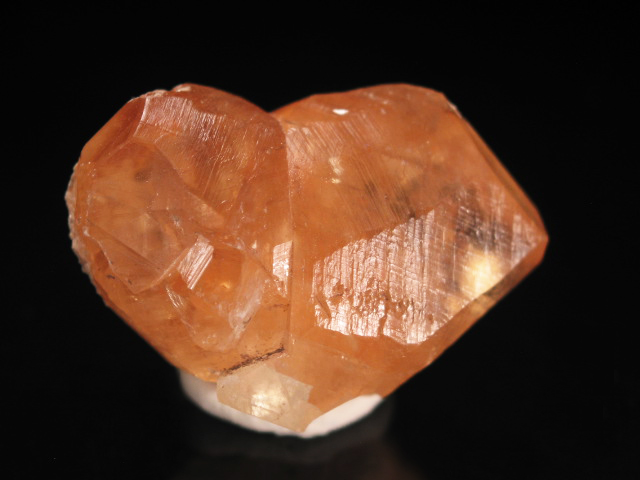



.jpg)








.jpg)







.jpg)
.jpg)



















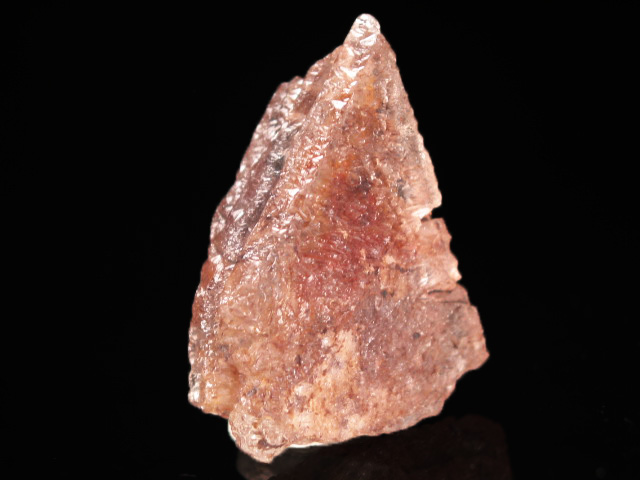


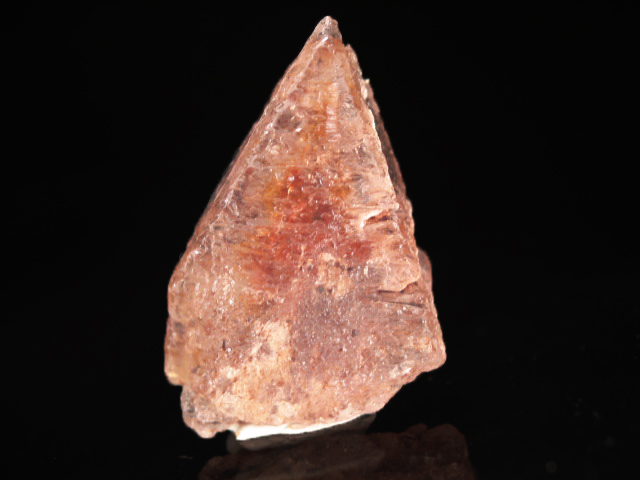














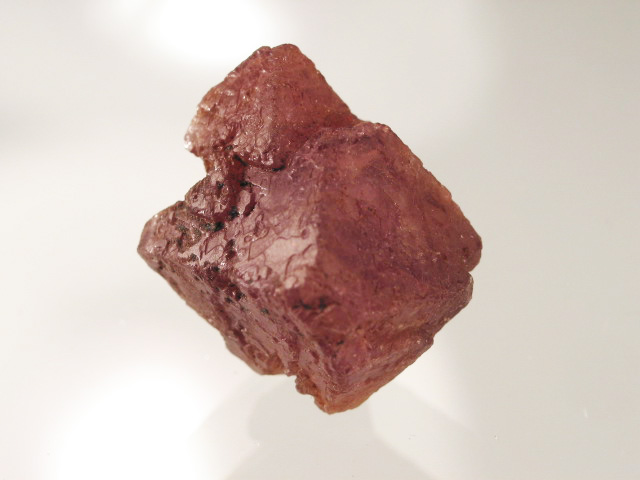














.jpg)


.jpg)


.jpg)

.jpg)

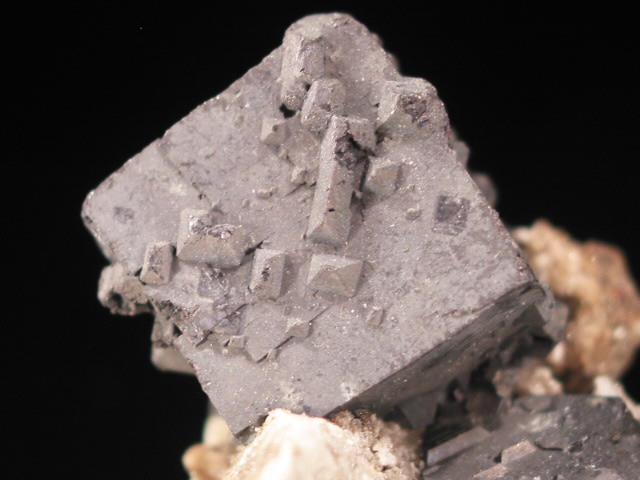
.jpg)
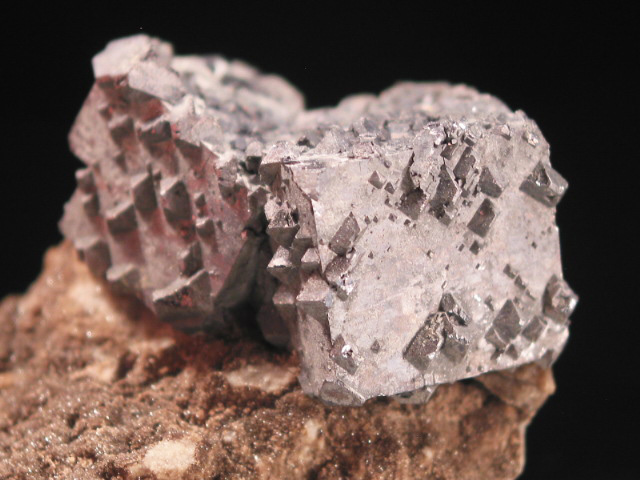
.jpg)
.jpg)
.jpg)
.jpg)







